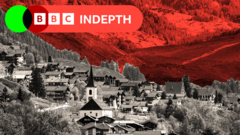In a picturesque valley of Switzerland, the tranquil village of Blatten has become a haunting reminder of nature’s ferocity. Following an unprecedented landslide triggered by thawing glaciers, the village has been all but erased, leaving its 300 residents grappling with loss and uncertainty. Just two months have passed since geologists warned of the mountain's instability, and many knew that the worst was imminent. The collapse that occurred has left whole neighborhoods buried beneath rock and ice, prompting emergency evacuations and igniting a costly recovery effort.
The inhabitants of Blatten face the daunting challenge of relocating and rebuilding as they mourn not just their homes but the rich cultural tapestry woven into their daily lives. Local hotelier Lukas Kalbermatten lamented, "All this is gone," reflecting on the cherished memories now buried under the debris. Plans are underway for a massive clean-up, with hopes to clear and rebuild by 2029 at an estimated cost of up to a million dollars per resident, prompting public scrutiny over whether these funds represent a worthwhile investment.
While efforts to salvage the remnants of Blatten continue, climate scientists warn that Switzerland's mountainous territories are becoming increasingly precarious as glaciers recede and permafrost thaws. Matthias Huss, a glaciologist at Zurich’s Federal Institute of Technology, underscores that human-induced climate change is significantly compounding the risk of such disasters, creating a future where incidents like that of Blatten may become more commonplace and unpredictable.
The fear of losing not just homes but an entire way of life has led to soul-searching among Swiss citizens, with discussions about the sustainability of preserving alpine villages. Editorial voices in influential publications have challenged the practicality of maintaining all communities in the mountains, amidst fears that an increasing number of residents may need to abandon their deeply-rooted "heimat" to protect their lives.
Elsewhere in Switzerland, other villages face lurking dangers from geological instability. In Graubünden, the mountain village of Brienz remains uninhabitable due to similar concerns, illustrating just how widespread and urgent the issue has become. Concerns are rising that if aggressive measures aren’t taken, the unique alpine cultures tied to these communities may slip away forever—taking with them the traditions, customs, and collective memories intrinsic to the Swiss identity.
As recovery operations ramp up, there is a palpable sense of determination among those affected. Matthias Bellwald, the interim mayor supervising the aftermath, exudes resilience amid the chaos. “You cannot hold back the whole mountain,” he insists. With helicopters constantly ferrying debris and soldiers supporting cleanup efforts, the focus remains on the future—one where the indomitable spirit of the Swiss alpine community seeks to rise once more from the rubble, even as they confront the vast uncertainties outlined by a changing climate.
The conversation continues—how can Switzerland honor its history, protect its people, and simultaneously nurture the landscape that has shaped its identity? It’s evident that the path ahead will not be simple, requiring a thoughtful blend of tradition and innovation to forge a sustainable future for its alpine regions.
The inhabitants of Blatten face the daunting challenge of relocating and rebuilding as they mourn not just their homes but the rich cultural tapestry woven into their daily lives. Local hotelier Lukas Kalbermatten lamented, "All this is gone," reflecting on the cherished memories now buried under the debris. Plans are underway for a massive clean-up, with hopes to clear and rebuild by 2029 at an estimated cost of up to a million dollars per resident, prompting public scrutiny over whether these funds represent a worthwhile investment.
While efforts to salvage the remnants of Blatten continue, climate scientists warn that Switzerland's mountainous territories are becoming increasingly precarious as glaciers recede and permafrost thaws. Matthias Huss, a glaciologist at Zurich’s Federal Institute of Technology, underscores that human-induced climate change is significantly compounding the risk of such disasters, creating a future where incidents like that of Blatten may become more commonplace and unpredictable.
The fear of losing not just homes but an entire way of life has led to soul-searching among Swiss citizens, with discussions about the sustainability of preserving alpine villages. Editorial voices in influential publications have challenged the practicality of maintaining all communities in the mountains, amidst fears that an increasing number of residents may need to abandon their deeply-rooted "heimat" to protect their lives.
Elsewhere in Switzerland, other villages face lurking dangers from geological instability. In Graubünden, the mountain village of Brienz remains uninhabitable due to similar concerns, illustrating just how widespread and urgent the issue has become. Concerns are rising that if aggressive measures aren’t taken, the unique alpine cultures tied to these communities may slip away forever—taking with them the traditions, customs, and collective memories intrinsic to the Swiss identity.
As recovery operations ramp up, there is a palpable sense of determination among those affected. Matthias Bellwald, the interim mayor supervising the aftermath, exudes resilience amid the chaos. “You cannot hold back the whole mountain,” he insists. With helicopters constantly ferrying debris and soldiers supporting cleanup efforts, the focus remains on the future—one where the indomitable spirit of the Swiss alpine community seeks to rise once more from the rubble, even as they confront the vast uncertainties outlined by a changing climate.
The conversation continues—how can Switzerland honor its history, protect its people, and simultaneously nurture the landscape that has shaped its identity? It’s evident that the path ahead will not be simple, requiring a thoughtful blend of tradition and innovation to forge a sustainable future for its alpine regions.


















